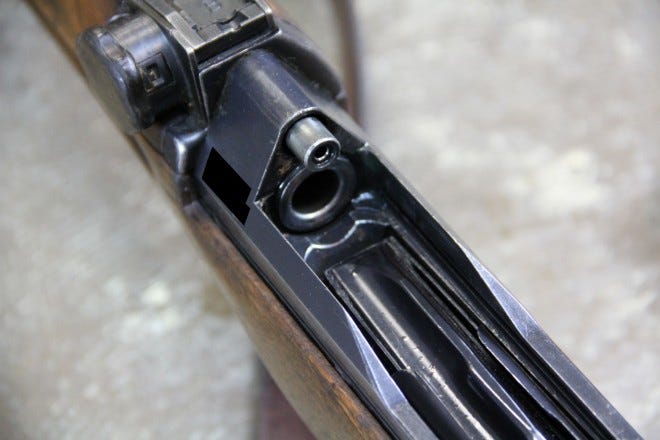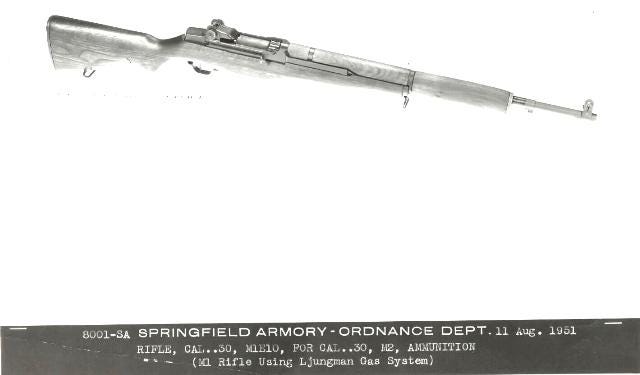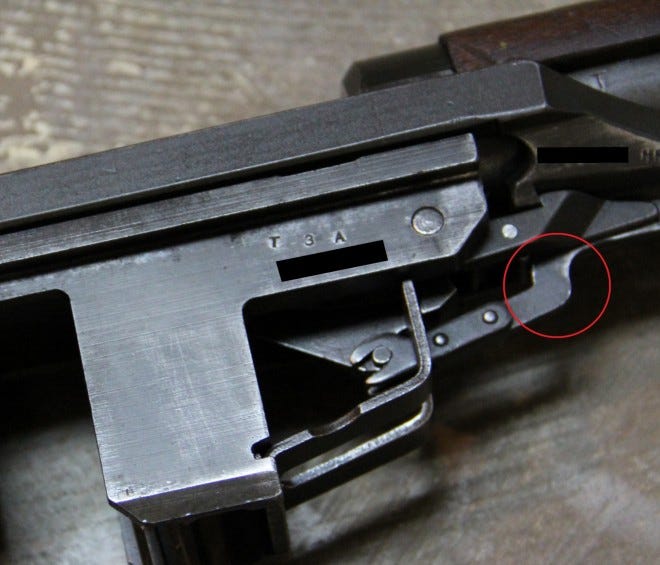The M-1 rifle is the most deadly rifle in the world.
– General George S. Patton, April 3rd, 1944
Hindsight is different when applied to the distant past of someone else than when applied to the recent past of oneself. Patterns jump out that might not have actually existed, original motivations may become lost, and the concerns, considerations, and limitations of the time evaporate after the fact, or become obscured, or buried deep within archives. What might seem like an obvious solution to a problem faced in the distant past might not have been so obvious then, or might not have been available to those alive and involved at the time. It’s easy to sit back in far-removed retrospect and say “they shouldn’t have done X” or “they should have done Y”; it is much harder to say these things with meaning. However, retrospect is necessary; therefore great care should be taken in having a well-developed, critical view of the past that not only seeks to correct its errors, but fully understand its work. It’s in this spirit that I undertake to offer sound criticism on one of the finest rifle designs of all time: The M1 Garand. The Garand was both a remarkable and flawed design. Several of its aspects tarnish in the retrospective, and these bear discussion. Likewise, it also had many very positive and excellent aspects that do not often receive recognition, and I think it’s only fair to begin with those.
I. The Good
1. Receiver Length and Weight
The M1 rifle’s receiver is fantastically designed in this respect. It is one of the few early selfloading designs to offer a receiver as short as competing bolt-action rifles, and the small and light receiver was a major component in the Garand achieving a similar weight to existing military repeating rifles. Compared to designs like the FN-49 and SVT, the Garand has a positively miniscule receiver footprint. In terms of receiver length, it’s only rivaled by the MAS 38 and Pedersen rifles, and its receiver is certainly lighter than the former’s.

This compactness of the receiver on the Garand lent in no small part to its handling, which was much closer to that of the bolt action rifles of the day than its self-loading contemporaries. Even in the 21st Century, the Garand still has one of the shortest receivers of any self-loading full-caliber rifle, even though it is chambered for the very long .30-06 caliber.
2. Anti Pre-Engagement
“Anti Pre-Engagement” is not a term readers are likely to have heard, but it’s an important one for the design of repeating arms. For an autoloading weapon with a locking bolt mechanism that is actuated by the compression of the bolt and carrier (as in most designs), it is important that the locking mechanism not be able to lock too early. In many designs, this is done by simply not giving the mechanism room until it is in the right position for locking.
For example, in an AR-15, the bolt is prevented in its rotation by the inside of the receiver, which bears against the cam pin. Once the bolt has reached the end of its travel, a special cutout in the side of the receiver, visible from the outside as a small “hump” on the side of the receiver, allows the cam pin to rotate and the bolt to engage. While this system works very well, it means that the bolt is trying to engage throughout its travel forward as the force of the ammunition and friction of the magazine tries to force it rearward. This induces friction between the moving parts and the receiver, which must be overcome for reliable functioning.
There is a more elegant way to overcome this, which has been described as an “anti pre-engagement mechanism”. The Garand features this. Essentially, instead of the locking element trying to actuate throughout its travel in the receiver, the Garand features a shelf in the operating rod:

Another flat surface on the bolt lug rests against this shelf during cycling, preventing the bolt from trying to make a turning move, and reducing friction during operation. Just before locking, a bump in the receiver knocks the bolt out of alignment with this shelf, allowing it to complete its rotation.
Interestingly, while the post-war M14 rifle disposed of the anti pre-engagment mechanism in favor of a roller, the Russian Kalashnikov rifle – also derived from the Garand – has retained it through the latest AK-100 series variants. No doubt that rifle’s tremendous reputation for reliability owes something to this feature.
3. En-Bloc Loading
The en-bloc clip loading system has received a bad rap in recent years. Seen as being overly complex, clumsy, and unnecessary, many feel it was a mistake to include en-bloc loading in the Garand, and that it should have been fed from detachable magazines, instead. The truth is not so simple.
In the early days of repeating rifles, there were four primary types of loading: Single loading, as in the Lebel and Krag rifles, en-bloc clip loading, as in the Steyr, Berthier, and 1895 Lee designs, magazine loading – proposed several times, but especially by Mr. James Paris Lee who designed numerous weapons, including the Lee-Enfield rifles that would soldier on into the late 1950s, and stripper clip loading, used by Mausers and most other types (including, in practice, the Lee-Enfield). Single loading was slow, and clearly obsolete; those countries with rifles constrained by the need to load loose rounds into the receiver, one at a time, tried desperately to replace them, some with great success (USA) and some with much less success, until after WWII (France). Magazine loading was clearly the ideal; it was fast, self-contained, potentially able to be done one handed while on horseback, and opened the possibility of greater magazine capacities. It had one flaw, however, which was that it was very, very expensive in comparison to the other types. A detachable magazine cost several times (up to or exceeding an order of magnitude more) than stripper or en-bloc clips, and no nations could afford to arm all of their troops with arms and enough detachable magazines to reload them in this way. (Eventually, most nations would reach a compromise in issuing large numbers of clip-fed rifles alongside far fewer magazine-fed support weapons such as light and sub-machine guns.)

So it was thus down to stripper or en-bloc clip loading for the practical military weapon of the early 20th Century. Most nations chose stripper clip loading, for its very low expense, but en-bloc clip loading was often considered superior, as the ammunition was contained in a single packet during loading (instead of being stripped off), and it was much easier to load the weapon from unsupported positions (such as on horseback).
John C. Garand surely knew this; his en-bloc loading design was building on the knowledge of the period to field the best affordable rapid-fire weapon possible.
4. Production Engineering
John Garand was a machinist with a passion for target shooting, and it is perhaps the result of his expertise on the factory floor that the Garand rifle enjoyed its most significant advantage over its stablemates. Where other selfloading rifle designers could not answer the question of how, exactly, their weapons could be produced in the quantities needed to arm a nation’s entire armed forces, Garand could. Garand’s designs of horizontal and vertical mill cutters enabled the Garand rifle to be produced in numbers large enough to arm every US Army rifleman. While I am not qualified to give an in-depth discussion of John Garand’s involvement on the factory floor, there is no question at all in my mind that it was this that most set apart the M1 rifle: John Garand’s greatest contribution to the American rifleman – the tooling used to make his rifles – never saw a battlefield.
II. The Bad
1. Gas System

Gas-actuated selfloading rifles were something of a bugbear for many nations before the Second World War. Both German and American procurement maintained that any rifle with a hole drilled in the barrel would be unsuitable for adoption. As a result, both countries’ selfloading rifle programs were set back by this; the Garand wouldn’t enter full-swing production until 1940 (despite being adopted in 1936) and the Germans would struggle with their designs until the middle of World War II.
As a result of the Americans’ concerns, the Garand entered production with a “gas trap” system, which tapped gas as it left the muzzle to operate the rifle. In consequence, the gas block was mounted to the very end of the barrel, adding weight and hindering the weapon’s balance. Further, gas was tapped where pressure was lowest, greatly reducing the amount of available energy needed to operate the action reliably. The functioning of the gas trap system was quickly found to be unsatisfactory, and the gas traps were removed, holes were drilled in the barrels, and a redesigned and more conventional gas block was added. However, the Garand’s gas system still added weight to the front of the weapon, and still tapped relatively low-pressure gas. One can’t blame the Americans (or the Germans) for what they didn’t know, but in hindsight it is clear a different gas system – at least one designed from the outset to tap gas through a port in the barrel, if not a completely different type – would have improved the Garand’s design greatly.
By the time of the Garand’s adoption, the French had over four decades of experience with selfloading weapons, and knew that gas tapped from a hole drilled in the barrel would not present a significant issue. A French weapons inspector by the name of Rossignol had developed the direct impingement gas system by 1896, and in the years before and after World War II it found favor and was perfected by French small arms designers. By the early 1930s, the direct impingement system had been tested extensively by the French, eventually resulting in the highly reliable MAS 38.

During the war, one of the major focuses of the various programs to improve the Garand rifle was to replace the gas system with one that would function better and improve the balance of the rifle. Many different systems were tried, including the French favorite, direct impingement. By 1944, a rifle resulting from this line of experimentation had been developed, called “M1E10”, shown below.

Direct impingement wouldn’t necessarily solve the Garand’s gas system issues – only careful design and thorough testing of the gas system could do that – but its maturity during the same period as the Garand rifle’s development does illustrate the existence of lighter, better functioning alternative gas systems available during the development of US selfloading rifles in the 1920s and ’30s.
In 1943, the White “cutoff” gas system would also be applied to the Garand mechanism in the M1E4 rifle. This combination would finally be vindicated – albeit briefly – with the adoption in 1957 of the M14 rifle.
2. En-Bloc Mechanism

The en-bloc loading system of the Garand – while certainly a good idea for the period in which it was designed – has some problems in its execution. The biggest problem comes from the combination of function of the follower and operating rod return spring. This spring, which both actuates the forward motion of the weapon and pushes the cartridge stack upward during firing, couples the gas piston’s stroke to the en-bloc ejection mechanism. The details of how this works are thoroughly explained in the video below:
Note the dog-legged section of the Garand’s magazine follower arm. This dog leg is finely calibrated to actuate the operating rod catch when it reaches the end of its upward travel, after the last round has been ejected. The operating rod catch also combines functions: when cammed up it automatically disengages the en-bloc clip retaining latch, allowing the forcible ejection of the en-bloc clip by the clip ejector spring and arm.
This is an ingenious system, but one that invites potential problems. When pressure is excessive and the operating rod is accelerated to the rear too forcefully, it can bottom out and bend the magazine follower arm, which will subsequently cause the premature ejection of the en-bloc, before all rounds have been fired. This is not an uncommon problem with the Garand; one rifle I owned previously was damaged in this manner.
Further, the combination of functions means that troubleshooting a rifle that ejects its clip too early is much more complex than it could be.
This is perhaps not so great an issue, but it’s one that could have been avoided by separating the functions of the follower arm and operating rod spring, or in retrofit by providing the operating rod with a place to bottom out before it reached its final travel. Other en-bloc loading rifles, such as the Berthier and Steyr M95 do this; though they are not self-loading, they providing some example of how this could have been remedied at the time.

3. Moving Parts Mass Ratio
One design parameter heavily emphasized in the design handbook Technical Notes: Small Arms Weapons Design published by the US Army Weapons Command in 1968 was that of the ratio of the primary moving parts group mass (e.g., the carrier) to the secondary moving parts group mass (e.g., the bolt assembly). It is noted that this ratio is highly important:
The components accelerated directly by the gas are referred to as the primary mass, and includes the piston, operating rod, and any other directly connected mass, depending upon the weapon design. As this primary mass moves to the rear, it unlocks the bolt and carries the bolt assembly, which is called the secondary mass. For smooth functioning, the primary mass should be considerably heavier than the secondary mass. That is, the recoiling operating rod or bolt carrier develops a given kinetic energy from the gas pressure. When it unlocks the bolt and starts carrying it rearward, kinetic energy is transferred from the operating rod to the bolt. This is reflected in a sudden drop in operating rod velocity. The nature of this velocity shift determines the degree of inertia loss of the primary mass and if this is high, function will be erratice. The primary mass should be divided by the secondary mass and is called the MASS RATIO, and this should be at least 3.
In other words, for proper functioning of a selfloading weapon, the carrier should have as much mass as possible relative to the bolt. This can be achieved either by increasing the weight of the carrier, or decreasing the weight of the bolt.
The Garand scores acceptably in this respect, with a mass ratio of less than 4. In contrast, both the AK and AR-15 – much more modern rifles – have mass ratios greater than 5, giving them an advantage in functioning.
Though the Garand scores below par in this regard when compared to modern weapons, it is fairly comparable to its contemporaries. Underlining that the mass ratio of the M1 is lower than more modern designs shouldn’t be considered evidence of shortcomings in the design process, but rather only as a note of one way in which selfloading and automatic rifles have gotten much better since their first generation.
III. The Ugly
The most significant – and obvious – flaw of the Garand, however, is the design of its action. Unlike most contemporary (and even most earlier) selfloading rifles, and to a greater degree even than nearly all bolt action infantry rifles, the Garand’s action and moving components are exposed to the elements. Consider the image below:

In contrast to other designs, both those more modern and those contemporary to it, the M1 Garand rifle is at a much greater risk of foreign matter ingress slowing or stopping entirely the operation of the weapon. With the bolt closed, dirt, debris, and dust are allowed through the openings between the bolt and the receiver; with the bolt open – as when loading the rifle – the locking surfaces are unprotected to assailing grit and other potential obstructions, which if fouled could prevent the closure and locking of the bolt, or even create an unsafe firing condition.
Why was the Garand not designed with greater protection of its moving parts, especially the locking surfaces? It’s difficult to know; but John Garand surely had his reasons. It is, though, an aspect of the design rightly forgone in the great majority of other selfloading service rifles.

IV. No Glory Lost
Casting a critical eye to the past does not imply a lack of appreciation of it. The Garand’s design did have flaws, yes, but the fielding of a self-loading rifle – for the first time anywhere in the world – to every rifleman in an army is an achievement worthy of very great praise. General Patton’s words at the beginning of this article speak to how radically autoloading infantry weapons augmented the capabilities of the rifleman; a rifleman armed with an M1 Garand need focus on nothing else but killing the enemy. I have mentioned the French; in their quest for the perfect infantry selfloader, they delayed production again and again to evolve their designs to meet changing requirements and improve performance. This finally resulted in the MAS 49 rifle – a superior rifle in almost every way to the Garand and in many ways everything the French had ever wanted in an arm, but fielded more than a decade later than the American weapon that armed American riflemen in the Second World War and Korea.
For certain, I can think of no better armed soldier in the year 1941 than the United States’ GI.
Special thanks to Alex C., who supplied me with most of the pictures used in this article.


